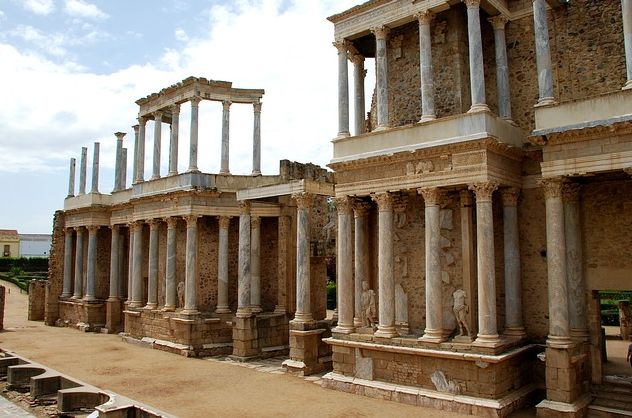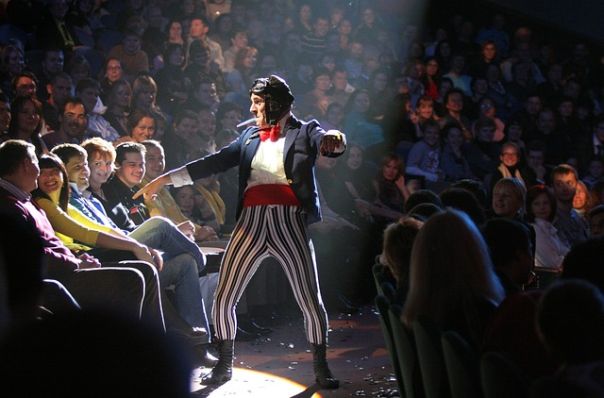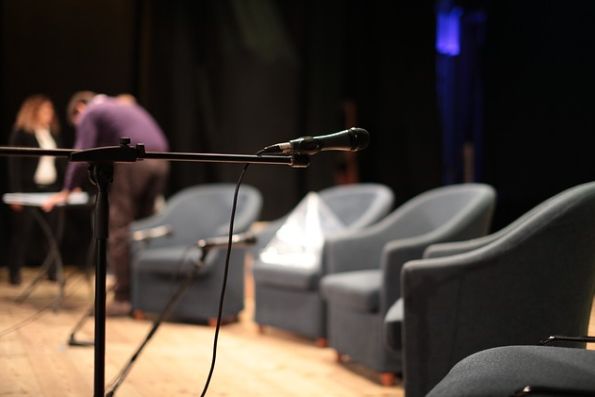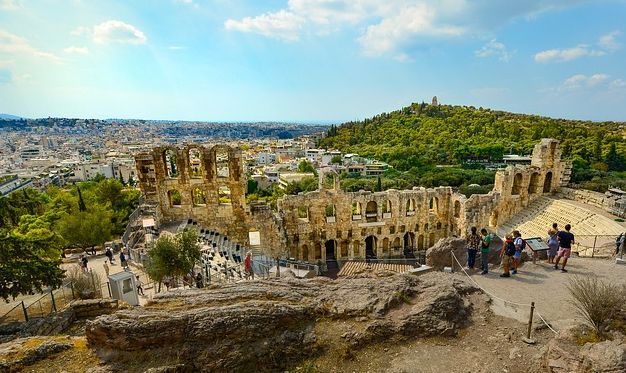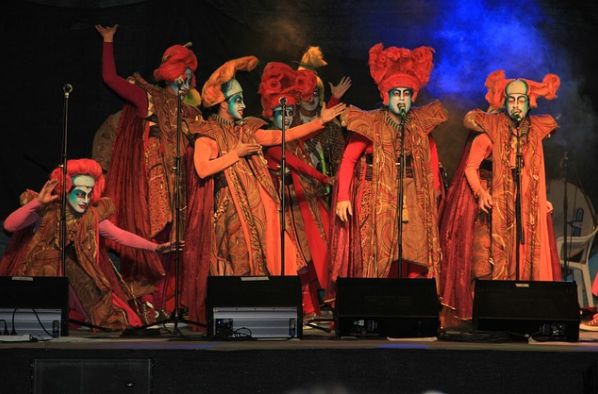Theater – Concept, Meaning, Types and Characteristics
Contents
What is theater?
Theater is a representation made by the human being of the almost always real situation that is in the space of life and daily life of people. It can be said that the theater, besides being part of the culture of the people, allows them to recreate reality and thus distance themselves from it in order to reflect on it.
Thus the theater is within the performing arts because it takes place in a physical space in which events are acted to be seen by the spectators. In the theater, the performance is very gestural and with it the sound, which may or may not be music, becomes part of the performance and seeks to cause an impact on the audience, to attract, persuade and enchant the viewer.
The word theater comes from the Greek Theatron which means place to contemplate. Its most important characteristic is that the staging is totally live, and must have as a condition that there is a spectator audience and there is a story to tell and relate that is developed through a plot in which various elements such as actors, music, sound, scenery and above all much emphasis is placed on the gestural, non-verbal language that is communicated through gestures and acting especially if it is to communicate emotions.
So it could be said that the soul of theater is the communication of emotions through the emphasis placed on gestures. Likewise, the theater receives this name not only to the performance but also to the physical space where this performance takes place. It must also be said that the theater is not only the scenery, the actors, the plot, but also the costumes, because it defines the personality of the actors, visually communicates through it as a symbol of hierarchies and social situations, since with it, the performance is located in time and space.
Concept of Theater
Theater, in the dramatic arts, is an art that deals almost exclusively with live performances in which the action is precisely planned to create a coherent and meaningful sense of drama.
Although the word theater derives from the Greek theaomai, meaning to see, the performance itself can appeal to the ear as well as the eye, as suggested by the interchangeability of the terms spectator and audience. Sometimes the appeal is strongly intellectual, as in William Shakespeare’s Hamlet, but the intellectual element itself is no guarantee of good theater.
There is a widespread misconception that the art of theater can be discussed solely in terms of the intellectual content of the script. However, theater is not essentially a literary art, although it has been taught as such in some universities and schools.
History of Theater
What stands out the most in the theater is the performance of emotions, which must be very marked and even more so must be the passage from one emotion to another, for example from laughter to tears from one moment to another and thus, to awaken emotions in the audience.
Theater dates back to Ancient Greece, as festivals and celebrations to the god Dionysus, the god of wine. During the grape harvest, people sang a hymn called dithyramb, which was recited in song and with live interpretation, using costumes. Later this interpretation was progressively extended for each specific god.
Theater is undoubtedly the most expressive medium of storytelling, and is constantly adapting to changing times. Although today’s audiences generally experience live storytelling from the comfort of living rooms and theaters for pleasure only, this was not always the case. Theater companies of the past went to great lengths to tell their stories, and audiences had and have a very different experience than today.
While mankind has been transmitting stories orally since the development of language, the institution of theater did not begin until much later. Ultimately, the earliest versions of theater were very different from a theatrical performance that one might attend today.
The plays of the past had a stronger basis in religion and tradition, and early Greek and Chinese performances are especially rich in religious dedications and communal traditions. Thus, the history of ancient Greece is intimately linked to the theater.
The first plays were performed in homage to the god Dionysus, the god of wine and fertility. Choirs began to perform hymns written in his honor, which were nicknamed dithyrambs, then these choirs gradually began to dress up in costumes and masks, but still did not resemble the theater as it is known today.
Characteristics of the Theater
Ever since Aristotle discussed the source and purpose of theater in his famous treatise Poetics (c. 330 B.C.), the function and characteristics of theater have been widely debated. Theater was used as a ritual of political conduct, moral instruction, entertainment, and also sought to change consciousness by generating the demonstration of movement and noise.
Theatrical production involves the use of props and sets, costumes, lighting and masks, as well as makeup, in addition to a room for functionality, and also an auditorium, which is the space for the spectator, which can overlap, especially in productions after the twentieth century.
Theater is construction, involving music, literature and dance, acting, in an amalgam of art and design. Basic performances function as the work of an artist and may depend on localized objects and space. Many performances require the efforts of professionally trained and creative individuals.
In drama, trends change from one generation to the next and across cultures, however, most could be equally categorized as symbolic or presentational. Pre-Renaissance Western American, Asian, African American, along with 20th century avant-garde theater is presentational.
What are the stages of theater?
Although theater has existed since prehistoric times with rites and imitations of animals and characters. The first stages of differentiation in theater were in ancient Greece with two types of plays: those that were very melancholic, in which dramatic stories were staged with sad and somber endings, but in them the mystical interventions of the gods were exposed.
Also, there were the comedy plays where the rulers of the time were imitated in a burlesque way. Thus, it can be said that theater has been changing to the same extent that the different civilizations and societies have changed.
However, it is important to point out that each civilization and culture has its own theater.
Classical Theater
From Western postulates, this theater is called classical, because it is related to civilizations of ancient Greece and Rome, in addition, the plays are written in the classical languages of Greek and Latin. Learn here the complete information about classical theater.
Greek Theater
The first classification that arises in Greece has four theatrical forms such as tragedy, satirical drama, comedy and mime. The first two were performed for adult audiences and the last two for children. In the beginning, the performance was only of men with routine clothes and masks. Later the theater spread to other civilizations such as the Romans.
This theater as such is said to be glimpsed as such in the third century B.C. at first with religious festivals, then it became entertainment, hence the most popular form was comedy. Likewise, it is reported as the beginning of the theater of dramatic creation in the 2nd century B.C., with the comedies of Plautus and Terence, as adaptations of the Greek comedy.
These plays were developed as intrigue of local character, although they also had a didactic value. The development of the plot was dynamic and to the taste of the public, many of its parts being sung. Likewise, the Christian church condemned the Roman theater because it considered its artists to be libertines and because the mimes satirized the characters of the church. These attacks contributed to the stagnation of theater for some five hundred years. Therefore, only the popular artists called minstrels and troubadours survived in the Middle Ages, who contributed to give continuity to the theater. Learn more about the Greek theater here.
Roman Theater
When the Republic of Rome was created and expanded in the 4th century B.C., Greek territories and the culture of those peoples were annexed, being the Greek theater and theatrical architecture part of the heritage of this new republic. Therefore, the Roman theater itself was developed in the third century BC and theatrical production was associated at first with religious festivals, which was then eliminated as the number of festivals increased, turning the theater into an entertainment and from this type of theater emerged the medieval theater. Get to know the complete information about the Roman theater.
Medieval Theater
This theater has the form of liturgical drama and was reborn in Europe in the Roman Catholic Church. Likewise, this theater was often carried out through festivals of pagan and popular type. Therefore, in the 10th century, the different ecclesiastical rites, such as the mass, were performed as a dramatic representation. Get to know the complete information on medieval theater.
Religious Theater
This theater is defined as the liturgical drama present during the following two hundred years from the different biblical stories with the performance of the altar boys and young people of the choir. Thus, in the beginning, the vestments for the celebration of the mass and the architectural forms of the church were sufficient as scenery. Later, however, it was organized more formally. Therefore, the stage was divided into two parts, the mansion and the stalls. This space consisted of a scenic structure, a small stage, imitating the Garden of Eden, Jerusalem and Heaven. Learn more about the religious theater.
Medieval Deep Theater
This theater of the fourteenth century, separated from the liturgical drama and performed outside the churches, particularly on the feast of Corpus Christi. It then changed to cycles that could count up to 40 dramas. Therefore, it is thought that although they are similar to liturgical dramas, the cycles were given independently.
Therefore, they were produced with a whole community every four or five years. Get to know the complete information about the deep medieval theater.
Renaissance Theater
With the Protestant Reformation, the religious theater of the middle of the 16th century disappeared as such, and a new and dynamic profane theater was formed. In this theater the acts and cycles are simple, different and far from the dramas of Shakespeare and Molière, passing from the themes of the low Middle Ages about the struggle of humanity and adversities, to more secular themes and more temporal concerns with the reappearance of the comic and the grotesque.
Neoclassical Theater
This theater is the result of a purely academic process, therefore, it does not evolve from religious forms, nor does it evolve from already existing popular and dramatic practices.
Theater of the 18th century
This theater was European, of actors, dominated by performers with plays written and adjusted to their style. Likewise, these actors adapted the classics to suit tastes and characteristics. Thus, Shakespeare’s plays, in particular, were altered to please the actors and conform to neoclassical principles.
African Theater
For example in Africa, religious rites were mixed with movement and gestural communication following music and dance, always using masks to represent roles and moods. These rites reinforce identity and social cohesion.
American Theater
In America, the Mayan, Aztec and Inca civilizations developed a form of theater that was related to agricultural festivals and also illustrated stories. Likewise, the Aztecs extensively developed mime, with two causes, one religious and the other burlesque. The Incas also made theatrical performances that served the interests of the state.
Also in India, mythological dramas on Hindu philosophy were performed in the form of song, dance and mime. Likewise, theater appeared in Japan in the 14th century, with lyrical-musical drama in the form of prose or verse on historical and mythological themes.
Avant-garde Modern Theater
Refers to the movements, grouped under this term avant-garde, that attempted alternatives to realist theater. They took naturalism beyond only a superficial and limited vision of reality, so they found a truth and reality in the spiritual, in the unconscious. Thus, they felt that the theater had lost touch with its origins, so they gave it a turn towards the symbolic, towards abstraction, the ritual, in an attempt to revitalize the theater.
Theater in the Modern Age
On the other hand, in the modern age, Renaissance theater went from theocentrism (centered on the gods) to anthropocentrism (centered on the human being), with naturalistic plays, seeking the recovery of reality, of life in movement and of the human figure in space, with illusionist scenarios. Tragedy was also developed in the Baroque theater, based on the inescapability of destiny, with a classical tone and a very ornate scenery, following the Baroque trend.
Theater of the 19th century
In the 18th century, specific philosophical ideas took shape, which finally ended up merging and consolidating at the beginning of the 19th century, in a movement called Romanticism.
Romantic Theater
In the 19th century, the romantic theater appears, from the current of romanticism, in which sentimentalism, dramatism, with a predilection for dark and lurid themes, the exaltation of the natural and folkloric, stand out. Therefore, the romantic theater exalted the spiritual plane that humanity should transcend the limitations of the physical world. Therefore, the subject matter was drawn from nature and natural man.
Symbolist Theater
This theater was born with the symbolist movement in France in 1880. The symbolists carried out the “de-theatricalization” of the theater, that is to say, they removed all the technological and scenic obstacles of the 19th century, and replaced them with the spirituality coming from the text and its interpretation. Therefore, the texts were full of symbolism that was difficult to decode. Therefore, the rhythm of the plays was slow and dream-like.
Expressionist Theater
The expressionist movement boomed in the first two decades of the 20th century, especially in Germany. Violent and grotesque situations of the human mind were placed on stage, recreating a nightmarish world. Therefore, expressionism exacerbates distortion, exaggeration making suggestive use of light and shadow.
Then, also in the twentieth century, theater incorporated a diversity of styles, evolving according to the avant-garde artistic currents. In the 20th century, much more emphasis is placed on artistic direction and on visual and literary scenography.
Contemporary Theater
This theater was consolidated after pure realism ceased to dominate the popular scene after the First World War. Even though, realist theater continued to live on commercially, especially in the United States. However, psychological realism was more sought after, which is why dramatic and scenic resources different from realism were used for this purpose.
Theater of the Absurd
The term was coined by the critic Martin Esslin in 1962 to name some playwrights who wrote in the 1950s, mainly French, against the traditional concepts of Western theater.
In this sense, the theater of the absurd was created as a result of the rejection of realistic theater and its psychological basis, with a coherent structure, plot and reliance on dialogical communication. Therefore, each play has its own models and characteristics of internal logic, both comic, sad, pathetic, macabre, humiliating, distressing and violent. Thus the most important theoretical source was Antonin Artaud’s “Theater and its double”, published in 1938.
Western Theater
Western theater as such is reported as unknown, however it is believed to be linked in its beginning with religious rites and practices, which are still carried out to this day. What most determines it is the load of symbolism and ritualism present in its practices. Therefore, it is associated with representations of fertility, harvest celebration, shamanism and other similar sources.
What are the types of Theater?
The following are some of the existing types of theater, which will be developed in greater depth later on:
Dramatic Theater
In this genre actions of life are staged, dealing with everyday issues that mark the lives of people, deep themes that are developed through dialogue. It is classified into: historical, Elizabethan, lyrical, social, liturgical and satirical drama.
Melodramatic Theater
Melodrama is considered the most deeply rooted dramatic genre in the 19th century. Therefore, melodrama as literature was despised and undervalued because it used images of villains who were accommodating their moustaches or heroines attached to train tracks. Nevertheless, it represents a very popular form of theater in a way that had never been done before.
Tragic theater
It is a genre of traditional drama from which a fatal, dark situation that has a sad, depressive outcome is staged. Almost always product of the ineffable, dismal destiny. In this genre the characters face the designs of God, rulers and destiny. Stories such as impossible loves, deaths of loved ones, banishment, war, destruction.
Comic theater
It is contrary to the comedy, although traditional, with a happy ending, cheerful and optimistic.
From the comedy we have the comic theater, in which the characters face situations that make fun and laugh at the weaknesses, flaws, clumsiness of the character as the plot develops, the ending can be tragic or happy.
Children’s theater
Briefly, children’s theater is a piece that involves children as actors and/or audience. Children’s theater is created and presented specifically for children’s audiences, either by children’s actors, professional adult actors, or a combination of both.
Theater has always been a part of every culture since time immemorial. Therefore, it is almost impossible to suggest a specific date when children’s theater began.
children’s theater began. However, in terms of a scripted play, it is believed that children’s theater began in the late 19th century in Europe and took the form of touring companies with dramatizations of folk tales, fairy tales and the first to be widely recognized was Barrie’s Peter Pan in 1904 in the UK.
Tragicomedy Theater
Tragicomedy is a literary device used in works of fiction. It contains both tragedy and comedy, and most tragicomedy characters are exaggerated, sometimes there may be a happy ending after a series of unfortunate events. Also, jokes are incorporated throughout the story, to lighten the tone.
Therefore, the feeling and mood of the play at the end is neither happy nor somber. Although it is partly comic in structure, it also has a strong tragic story.
Open-air theater
It is the theater that takes place in the streets, squares, in improvised places away from the buildings specialized for such function. This theater seeks to bring the theatrical spectacle closer to the masses and can have some scenery or do without it. Thus, the style of representation is different from theater in a theater hall because the space is part of the play and can be interactive. It has a variant which is the invisible theater, where the audience is not aware that they are witnessing a play.
Puppet Theater
It is a type of theater that is performed with funny and common stories, using puppets that are personified according to the characters of the play and are made for children, but can also be mounted works for adults that can be mostly satirical and critical.
Pedagogical Theater
These are educational plays, used as interactive learning strategies, which can be performed at all educational levels, although they are more frequent at preschool and elementary school levels. They can also be of a religious nature, with multiple representations, carried out through stories that seek to teach different types of content and values.
Mime Theater
This theater is given through mimicry, seeking to express different emotions through actions and gesticulations performed with the body, face and hands. Therefore, the dialogues that are presented in other types of theater, with speech, are replaced by gestures and body movements, getting the viewer to grasp what the actor or mime wants to express, usually comic gestures, dedicated to awaken laughter in the viewer, but can also be dramatic and sad to make you cry.
Monologue theater
In theater, a monologue is a solo, solitary, is a speech presented by a single character, most often to express his mental thoughts aloud, but sometimes also to address directly to another character or the audience.
Monologue, in literature and drama, is a speech extended by one person, it is any speech of a certain length addressed by one character to a second person. There is also the soliloquy, which is a type of monologue in which a character directly addresses an audience or speaks his or her thoughts aloud while alone or while the other actors are silent.
Farce Theater
Farce, is a comic dramatic piece that uses highly improbable situations, stereotyped characters, extravagant exaggerations and violent jokes in the play. The term also refers to the kind or form of drama that is composed of such compositions. Thus, farce is generally considered intellectually and aesthetically inferior to comedy in its crude characterizations and implausible plots, but it has been sustained by its popularity in performance and has persisted throughout the Western world to the present day. Learn more about farce theater.
Vaudeville Theater
This theater is defined as a dramatic subgenre that unfolds as a frivolous, light and biting comedy, which shows mistakes and comic episodes, alternating songs and musical spaces, the name comes from the French vaudeville.
Its origin is in the minstrels who toured places doing songs and acting farces, which gave rise to this vaudeville theater. It is believed that the name of this theater is defined from 1450, by the songs and presentations of a fuller of the city. Another meaning is related to a satirical and political theatrical song, in which there are also certain dramatic pieces in which songs were not performed.
Shadow Theater
Of Chinese and Indian origin, this theater uses puppets instead of actors, and curiously, the audience never sees the puppets directly, but their shadows that are projected on a screen that is placed in front of the spectator. It is believed to be the ancestor of cinema.
Black Theater
In this theater, visual effects are emphasized by making an illusion of animated objects. Therefore, as the human eye does not distinguish black objects on black and this is the foundation of black theater. Therefore, in this theater there is a manipulation of objects where the “puppeteers” are all completely dressed in black and manipulate objects exposed to black light that seem to levitate. The most famous company of this theater is the Black Theater of Prague.
What is the Legacy of Theater?
The great legacy left by the theater, especially the Greek theater, is that the staging of reality made it possible to recreate and thus assimilate the wars, invasions and tragedies experienced by civilizations. In the same way, modern theatrical terms are crystallized in the production of Greek tragedies of the 5th century.
Thus, terms such as actor, chorus, theater, tragedy, protagonist, the term hypocrite, adding the term actress (after the first playwright Thespis), scene, orchestra (literally, a place to dance), prologue, monologue, dialogue, audience, antagonist, episode, all this vocabulary enriched the lexicography of language in all cultures.
At present the theater is a form of entertainment, but everything that is performed in theater today in tragedy, comedy, drama have their origin in Greece, because the theater was for the Greeks their best pastime.
Main Representatives of the Theater
The beginnings of the independent experimental scene date back to the early post-revolutionary years, when immediately emerged several ensembles. Most of the founding personalities of the progressive ensembles of that time are still active on the stage, although not all of them are active in non-established conditions.
One of the representatives are contemporary European creators, who transfer the procedures of auteur theater, sense of humor, current language or slang and typical themes of the formation of this theater from performances to television and entertainment formats.
In addition, numerous plays deal with historically difficult periods in Europe, which contributed to the cultivation of a documentary style. They follow the pattern of the mainly German post-war theater, as European theater has also become an important platform for social discourse during a delicate period of cultural and historical change.

